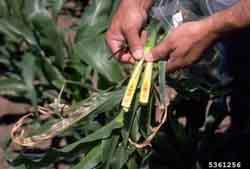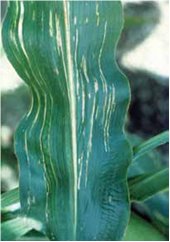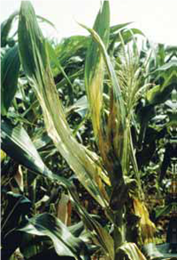CGKB News and events stog-maize
Safe transfer of maize germplasm
Contributors to this page: CIMMYT, Mexico (Etienne Duveiller, Monica Mezzalama, Eloise Phipps, Thomas Payne, Jesper Norgaard), Independent consultant (Jesse Dubin). IITA, Nigeria (M. Ayodele, L. Kumar).
CIMMYT, as one of the 15 CGIAR centers, has the mandate for care and maintenance of maize germplasm. The Wellhausen-Anderson Genetic Resources Center provides secure, long-term storage for critical maize genetic resources; facilitating their use to solve practical breeding problems; improving knowledge about genetic diversity; developing and assessing complementary strategies for in situ and ex situ conservation; exploring genetic diversity at the molecular level; helping develop global databases on maize genetic resources.
The Plant Genetic Resource Center’s specially designed vaults currently hold some 22,000 samples of maize and teosinte, a wild relative of maize. The Center also maintains a living collection of Tripsacum, a more distant maize relative.
Both CIMMYT and IITA have responsibilities for maize and the information on quarantine regulations and guidelines is presented for both institutions.
Information is included on:
- Import and export requirements for CIMMYT and IITA.
- Technical guidelines for the safe movement of germplasm and detection of relevant pathogens and pests.
- Best practices in place at CIMMYT.
References and further reading
Compendium of Corn Diseases. 1999. Third Edition. Editor, Donald White. APS Press, St. Paul, MN. USA. ISBN 0-89054-234-1.
Import/export of maize germplasm
Contributors to this page: CIMMYT, Mexico (Etienne Duveiller, Monica Mezzalama, Eloise Phipps, Thomas Payne, Jesper Norgaard), Independent consultant (Jesse Dubin).
It is very important to remember that an International Phytosanitary Certificate is always required for any plant germplasm exchange.
The requirements of countries that received seed from CIMMYT Headquarters located in Mexico, have been collected from the permits granted to CIMMYT for exportation of maize experimental seed. The information in this table was updated to September 2011. IITA import requirements are included.
- The information received from the same country may vary from a permit to another, therefore the latest has been considered the valid one.
- It is advisable before sending a shipment to contact the consignee in the recipient country to confirm the information reported in this table.
- Some of the pathogens listed are not proved to be seed borne (for example Burkholderia andropogonis, Cercospora zeae-maydis), nevertheless due to the fact that these pathogens are listed among the country requirements they were included.
Guidelines for the safe transfer of maize germplasm
Contributors to this page: CIMMYT, Mexico (Etienne Duveiller, Monica Mezzalama, Eloise Phipps, Thomas Payne, Jesper Norgaard), Independent consultant (Jesse Dubin): IITA, Nigeria (M. Ayodele, L. Kumar).
Technical Guidelines for the Safe Transfer of Germplasm and the Protection of CGIAR Germplasm Banks
Pathogens of quarantine significance of wheat tested by the Seed Health Laboratory of CIMMYT and IITA.
|
Viruses |
|
Maize dwarf mosaic virus
|
|
Sugarcane mosaic virus
|
|
Maize chlorotic mottle virus
|
|
Bacteria
|
|
Pantoea stewartii
|
|
Clavibacter michiganensis subsp. nebraskensis
|
|
Acidovorax avenae subsp. avenae
|
|
Fungi
|
|
Acremonium maydis
|
|
Claviceps gigantea
|
|
Cochliobolus heterostrophus
|
|
Gibberella moniliformis
|
|
Gibberella zeae
|
|
Glomerella graminicola
|
|
Khuskia oryzae
|
|
Peronosclerospora maydis |
|
Peronosclerospora philippinensis
|
|
Peronosclerospora sacchari
|
|
Peronosclerospora sorghi
|
|
Sclerophthora rayssiae var. zeae
|
|
Setosphaeria turcica
|
|
Stenocarpella spp.
|
|
Ustilago maydis
|
|
Insects
|
|
Trogoderma granarium
|
|
Prostephanus truncatus
|
|
Nematodes
|
|
Heterodera zeae
|
Bacteria - maize
Contributors to this section: CIMMYT, Mexico (Etienne Duveiller, Monica Mezzalama, Eloise Phipps, Thomas Payne, Jesper Norgaard), Independent consultant (Jesse Dubin).
Stewart’s wilt, bacterial wilt of maize
Pathogen name
Pantoea stewartii
Other scientific names
Erwinia stewartii
Importance
Plant resistance to this disease has considerably reduced its economic importance; nevertheless it is of high phytosanitary importance.
Significance
The most serious disease of sweetcorn, causing yield reduction and susceptibility to stem rot; less destructive in other types of maize. Outbreaks are generally sporadic.
The disease caused major losses in North America in the 1930s, but subsequently has caused only minor outbreaks, except for a few extensive epidemics on susceptible sweetcorn hybrids. The current relatively low economic importance of the disease in North America is due primarily to adequate levels of resistance incorporated into maize hybrids grown where the disease occurs. In sweetcorn, no or minimal losses occur in resistant hybrids, but losses can be significant in susceptible hybrids grown where flea beetles occur. Losses frequently range from 40 to 100% when susceptible sweetcorn hybrids grown under epidemic conditions are infected before the 5-leaf stage.
Severe losses due to Stewart's wilt were reported in Italy in the 1940s and 1980s, but the disease has not persisted in Europe due to absence of vectors.
Symptoms
First phase (wilt phase): sweetcorn particularly susceptible, not usually seen in other types of maize. Water-soaked lesions, turning long and pale green to yellow, with wavy margins, and running the length of the leaf. These streaks dry out and turn brown. Infection may move into the stem and spread through the vascular system, causing general stunting and wilting. Plants infected at seedling stage may be killed; if infected later they may reach a reasonable size. Severely infected plants may produce premature, bleached tassels that die before the rest of the plant, or those that set seed develop small nubbins with few kernels. Small water-soaked spots, which later dry and darken, may develop on the husk of the cobs; bacteria may exude in fine droplets on the inner face of the husk. Cavities may form in the stalk near the soil in severely infected plants.
Second phase (leaf blight): usually most apparent after flowering. Seen in non-sweetcorn maize which is usually resistant to wilt phase. Irregular, pale green to yellow streaks of variable length appear on leaves, originating from feeding marks of corn flea beetle (Chaetocnema pulicaria). May cause severe leaf necrosis, with whole leaves turning straw-colored.
Hosts
Major hosts: maize (particularly sweetcorn), teosinte.
Minor hosts: other Poaceae species including fodder plants, e.g. eastern gamagrass (Tripsacum dactyloides), and weeds.
Geographic distribution
Western USA and Canada, Mexico, Costa Rica, Puerto Rico, Bolivia, Brazil, Guyana, Peru, Austria. Various historical records in Europe and Asia where P. stewartii is now absent.
Indigenous to America; introduced elsewhere with seed.
 Typical Stewart’s wilt symptoms on Maize(photo: CIMMYT) |
Biology and transmission
The pathogen is primarily transmitted by the corn flea beetle, Chaetocnema pulicaria. Feeding wounds act as points of entry. Vectors overwinter the pathogen and cause secondary local spread. P. stewartii can also be seed-transmitted, and infected seed is likely to be the cause of international spread.
Detection/indexing methods used at CIMMYT
- Detection with ELISA using AGDIA protocol (http://www.agdia.com).
Treatment/control
- Chemical treatment can be applied to control the vector C. pulicaria.
Procedures followed in case of positive test used at CIMMYT
- The seed lot is destroyed (the pathogen is quarantined in Mexico).
References and further reading
CAB International. 2007. Datasheet: Pantoea stewartii. In Crop Protection Compendium, 2007 Edition. Published as CD-ROM and website. Wallingford, UK: CAB International.
EPPO. Data Sheets on Quarantine Pests: Pantoea stewartii subsp. stewartii. [online] Available from URL: http://www.eppo.org/QUARANTINE/bacteria/Pantoea_stewartii/ERWIST_ds.pdf. Date accessed 10 April 2010
EPPO Diagnostic Protocols for Regulated Pests PM 7/60(1): ,Pantoea stewartii subsp. stewartii. EPPO Bulletin 36: 111-115. [online] Available from URL: http://www3.interscience.wiley.com/journal/118562431/abstract Date accessed 10 April 2010
McGee DC. 1988. Maize Diseases: A Reference Source for Seed Technologists. St. Paul, MN: APS Press. pp. 36-38.
The CIMMYT Maize Program. 2004. ,Maize Diseases: A Guide for Field Identification. 4th Edition. Mexico, D.F.: CIMMYT. pp. 86-87. [online] Available from URL: http://www.cimmyt.org/english/docs/field_guides/maize/pdf/Maizediseases.pdf. Date accessed 10 April 2010
Goss’ wilt, Goss’ bacterial wilt and leaf blight, Nebraska leaf freckles and wilt, leaf freckles and wilt
Pathogen name
Clavibacter michiganensis subsp. nebraskensis
Other scientific names
Corynebacterium michiganense pv. nebraskense, Corynebacterium michiganense subsp. nebraskense, Corynebacterium nebraskense
Importance
The pathogen is confined to the USA, where the adoption of resistant hybrids has considerably reduced its economic importance. Nevertheless it is of high phytosanitary importance.
Significance
Discovered in Nebraska in 1969 and has gradually spread across the US corn belt. Aggregate losses are minor but may be severe in individual fields.
Symptoms
General stunting and wilting. On leaves, gray-green streaks along veins, with water-soaked spots that resemble freckles. Bacterial exudate may appear on diseased tissue. In stalk, rotting with discoloration of vascular bundles. Plants may be infected at any growth stage.
Hosts
Major hosts: maize, teosinte, sugarcane (accharum officinarum), sorghum (Sorghum bicolor), Sudan grass (Sorghum sudanense).
Minor hosts: triticale, barnyard grass (Echinochloa crus-galli), wheat.
Geographic distribution
Mid-western USA.
Biology and transmission
Most important inoculum source is crop residues, where the pathogen can overwinter. Injuries from wind or sand facilitate infection. It is also seed-transmitted (at low rates of transmission).
 Goss’s bacterial wilt(photo: IPM) |
Detection/indexing methods used at CIMMYT
- Isolation on CNS medium.
Treatment/control
- Resistance
Procedures followed in case of positive test used at CIMMYT
- The seed lot is destroyed (the pathogen is quarantined in Mexico).
Maize bacterial leaf blight, bacterial leaf stripe, red stripe of sugarcane
Pathogen name
Acidovorax avenae subsp. avenae
Other scientific names
Pseudomonas avenae, Pseudomonas avenae subsp. avenae, Pseudomonas rubrilineans, Xanthomonas rubrilineans
Importance
Low economic importance, moderate phytosanitary importance.
Significance
Minor: disease occurs sporadically in India, but does not cause substantial crop damage. May be a concern where susceptible germplasm is grown in hot and humid areas.
Symptoms
May affect plants from seedling to post-flowering stages. Narrow, white/straw-colored/pale green lesions on leaves, initially oil-soaked and translucent. Under optimum weather conditions, lesions expand along veins producing a conspicuous striping, mainly in the youngest leaves. Stripes later become papery thin, dry, and brown, often with shredding of the infected tissue. Severe damage of the top leaves results in tassel rotting, when dead leaves enclose the tassel.
Hosts
Major hosts: maize, rice (Oryza sativa), sugarcane (Saccharum officinarum), sorghum (Sorghum bicolor).
Minor hosts: oats (Avena sativa), tea (Camellia sinensis), finger millet (Eleusine coracana), barley (Hordeum vulgare), millet (Panicum miliaceum), pearl millet (Pennisetum glaucum), foxtail millet (Setaria italica), yellow foxtail (Setaria lutescens), green foxtail (Setaria viridis), wheat.
Wild hosts: wheatgrass (Agropyron spp.), prairiegrass (Bromus catharticus), awnless brome (Bromus inermis), maintain brome(grass) (Bromus marginatus), fishtail palms (Caryota spp.), large crabgrass (Digitaria sanguinalis), barnyard grass (Echinochloa crus-galli), paspalums (Paspalum spp.), other grasses (Poaceae), teosinte.
Geographic distribution
Worldwide, though with generally limited distribution.
Biology and transmission
Seed-transmitted.
Detection/indexing methods used at CIMMYT
- Isolation on agar.
- Germination test on sterile soil.
Treatment/control
- None available
Procedures followed in case of positive test used at CIMMYT
- The seed lot is destroyed.
 |
 |
|
|
Bacterial leaf stripe (photos: CIMMYT) |
||
References and further reading
CAB International. 2007. Datasheet: Acidovorax avenae subsp. avenae . In Crop Protection Compendium, 2007 Edition. Published as CD-ROM and website. Wallingford, UK: CAB International.
McGee DC. 1988. Maize Diseases: A Reference Source for Seed Technologists. St. Paul, MN: APS Press. pp. 33-34.
The CIMMYT Maize Program. 2004. Maize Diseases: A Guide for Field Identification. 4th Edition. Mexico, D.F.: CIMMYT. pp. 88-89.



 stog-maize
stog-maize
